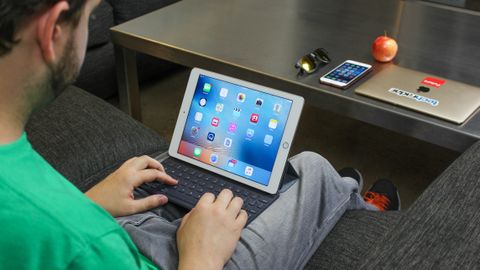Why you can trust TechRadar
It's easy to say that the iPad Pro 9.7 has the same display as the iPad Air 2. It's technically true, but not wholly accurate. It has the same size, resolution and pixel density as the Air 2.
There's more to this version of the Retina display, however, and the screen specs literally outshine what you will find on the bigger and seemingly more powerful iPad Pro 12.9 (2015).
Apple has introduced True Tone display technology, which dynamically adjusts the white balance of the screen to adapt its color and intensity to my environment. Just like the brightness slider, it's also handled automatically using four-channel ambient light sensors.
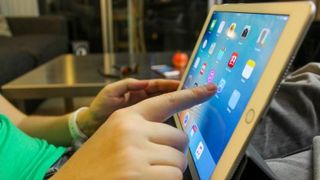
It's sort of like the Night Shift mode that made its debut in iOS 9.3. True Tone is easier on the eyes, making the screen look more natural and, more often than not, less blue.
I really enjoy the adaptive True Tone display setting and can't turn it off now.
Apple's goal isn't sleep here, but to ever-so-slightly nudge the iPad Pro 9.7 glow so that it looks like a piece of paper. It's odd-looking at first, but you get used to it over the course of a few days. I really can't turn it off now that it's on.
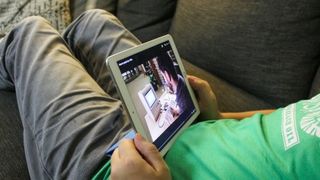
It's bright enough in sunlight for me to keep working, even if I'm likely to be sunburned.
With a 2048 x 1536 resolution and 264 pixels per inch, it's hard to pack in more pixels into a display of this side and having it matter. However, Apple decided to crank up the color gamut to give its new iPad Pro 25% greater color saturation than the iPad Air 2.
It touts the fact that this tablet uses the same color space as the digital cinema industry, and it's true, the screen uses a wider array of colors and look more vivid. That said, the average user I've shown this to sees this as a minor addition to an already excellent-looking display. This is really meant for digital artists and photo editors who are putting the Pro-level display to work.
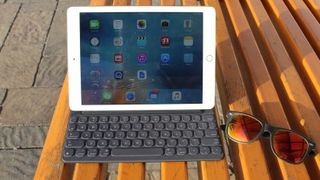
Everyone can get behind the return of the iPad's fully laminated display that presses the screen up against the glass without gaps and its even more important anti-reflective coating. Outdoors, I found the iPad Pro 9.7 to be bright enough in sunlight for me to keep working, uncomfortable and likely sunburned.
Of course, since launch the display on the iPad Pro 9.7 has been beaten by newer iPads, like the iPad Pro 11, iPad Pro 12.9 (2018) and iPad Pro 10.5, but it's still got a good screen.
Smart Keyboard
The iPad is slowly transforming into a computer before our eyes, and the latest move by Apple is the most striking: developing a keyboard for the iPad Pro line. This one, I must point out right away, is different than the third-party keyboards that are always Bluetooth-connected and often unreliable. Don't shrug it off as an optional accessory you should never consider.
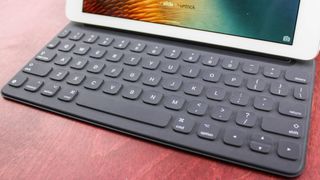
Apple's Smart Keyboard for the iPad Pro 9.7, in fact, isn't Bluetooth at all. It uses the new Smart Connector that magnetically fastens the new keyboard to the bottom (in landscape) of the tablet. It combines the tri-fold Smart Cover design with an extra fourth flap for the ultra-slim keyboard. It loudly snaps into place, but that just means it's secure enough to carry this iPad-keyboard combo by the tablet screen (the opposite of how you grab a laptop, unless you're under the age of 5).
The company boasts "No plugs. No switches. No pairing." To translate that into more iconic Apple words, "It just works." I've never had to charge this keyboard or set it up through a menu, since both power and data flow through the Smart Connector. But that's just where it gets started. How does the keyboard perform?
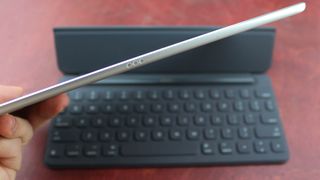
This is definitely a low-pile keyboard, and while not everyone will take a liking to it at first, I'm used to that given my everyday use of the New MacBook and new Magic Keyboard that's connected to my Mac Pro. It may be a challenge for others, but it's all a learning process. The good news is that while the keys are naturally smaller on the iPad Pro, they're made of fabric.
A fabric keyboard sounds like an odd choice, but it's been comfortable and resilient against my thousands of my mostly accurate keystrokes so far. In fact, I feel more confident with this iPad keyboard than my New MacBook keyboard, which uses plastic keys and has a more delicate butterfly mechanism. I've already had to get its entire top case replaced once.
I feel more confident with this iPad keyboard than my New MacBook keyboard.

I won't have an issue of getting crumbs, sand or grass in between these springy keys. Gone are the days when I blow debris off the keyboard only to have it lodge underneath the keys every single time. This keyboard is also water and stain resistant. How? Apple says it's made from a single sheet of custom-woven fabric and, of course, etched out the keys using lasers. Because - the future.
The future sure is wildly expensive, though. It costs $149 (£129, AU$229) for this fabric case, which is only slightly cheaper than the larger 12.9-inch Smart Keyboard. There are also a few compromises compared to a traditional laptop keyboard.
You won't find function keys along the top or an escape key. That's okay. Control Center (swipe up from the bottom on the touchscreen) handles most of the fn key workload: display brightness, volume slider, music playback controls, etc.
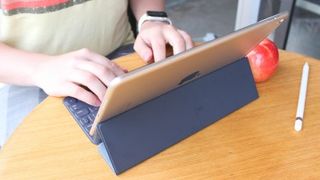
Keyboard shortcuts are also here: exiting to the home screen, switching apps and initiating a system-wide search. So are the usual bold, italics, underline and select all, and every app can have its own shortcuts.
Naturally, the shortcut list for non-Apple apps is extremely limited right now and there are no modifier keys letting me switch control and command like on my Mac.
I'm also hurting for a backlit Smart Keyboard. iPad Pro 9.7 is meant to be used in all sort of situations, and it's a bummer to have to shine an iPhone 6S Plus on the keyboard when it's lights out and I think of one more thing to add to this review before bed. I'm less confident we'll ever see backlighting from a fabric keyboard.
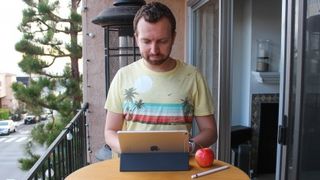
Finally, I can't use this keyboard case in every situation, as much as I like the fabric design. It just won't sit on my laptop unless I'm sitting flat. It's the exact problem I have with the Microsoft Surface Pro. In fact, Apple's tablet is like the Surface Mini that Microsoft never launched.
Thankfully - as of August 2016 - one of the big flaws was finally fixed as regional versions of the Smart Keyboard were released, meaning the currency keys will finally be in the right place for your territory.
Apple Pencil
I spent a lot of time toying around with the Apple Pencil and, thankfully, there are a more key apps today than when the original 12.9-inch iPad Pro launched alongside the accessory. There are a variety of blank canvas apps out there encouraging freehand art for this pressure and angle-sensitive stylus. But they're not all the same. It's the toolset on the sides and along the bottom that really matters.
I found FiftyThree's Paper to be one of the easiest drawing apps within the App Store followed by very customizable Procreate. What's surprising is that Apple didn't bother to make much use of its lag-free Pencil accessory with its own Notes app at first.
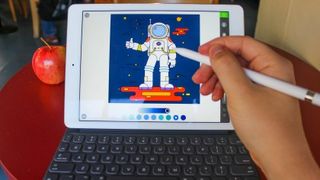
It wasn't until iOS 11 that Apple Notes expanded to include Instant Markup on PDF files and photos, Instant Notes on the lockscreen and Document Scanner to capture (and later markup) real-world documents. iOS 10 introduced real-time sharing capabilities.
However, at first, I was shocked to learn that I couldn't annotate on screenshots through the Photos app. iOS 10 fixes that problem, too, but it should really be among the editing tools from the beginning. Annotation is a key feature of the Microsoft Surface Pen, but here, I initially had to download an app called Skitch to circle some lines of text and show people the very important information.
Not a freehand drawing prodigy? That's okay. The Apple Pencil can still be a fun accessory thanks to apps like Pigment. It turned my 9.7-inch iPad Pro into a coloring book. I've never owned a coloring book this expensive before, but some things never change: I did get mad when drawing outside the lines.
As much as everyone joked that Apple's Pencil doesn't include an eraser on the other end, there's some truth to that cliched observational humor - especially when the Surface Pro's Pen does.
The biggest problem with the Apple Pencil is that it's expensive at $99 (£79, AU$165). I mean, people are buying inexpensive 8-inch Lenovo tablets running Android for that price, not a plastic tablet accessory. This Pencil doesn't have mainstream appeal for that reason, but it will tempt creative types who gravitate toward Apple products already.
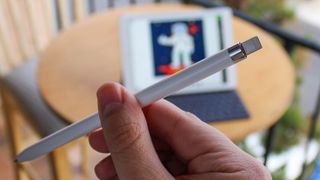
A smaller issues is in the way it charges. There's a very loseable cap on the end of this plastic input device and it reveals a Lighting connector - a male end of Lightning. This means in order to charge the Pencil, I had to either plug it into my iPad in an awkward looking, very breakable setup, or remember to bring the equally loseable Lightning-to-Lightning adapter (both sides female) with me in my backpack.
I chose to cautiously charge it via the iPad and endure strange looks. The good news is that the Pencil doesn't take long to charge and lasts 12 hours when at 100%. When I was down to 0%, I didn't have to panic, either. Apple built its stylus to regain 30 minutes of juice with just 15 seconds of charging. I can pretend I'm not with my iPad Pro 9.7 for 15 seconds.
Current page: True Tone Display, Smart Keyboard and Apple Pencil
Prev Page Introduction and design Next Page Specs and performance
Do you turn off your PS5 or put it in Rest Mode when you're done? According to Sony, the decision is a 50/50 split for all players

Google's 2024 Timeline update is like Spotify Wrapped for your travels

No iPhone, no problem – this Batman-style location tracker brings satellite messaging to any smartphone
